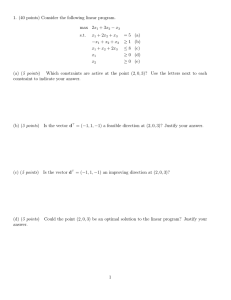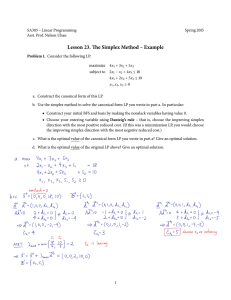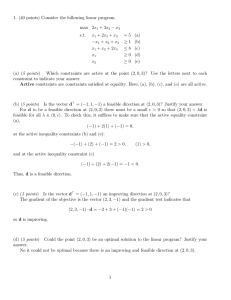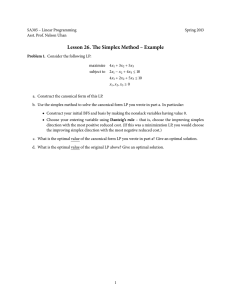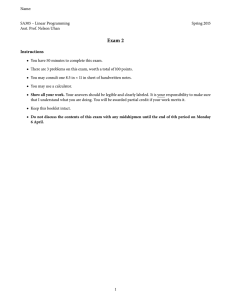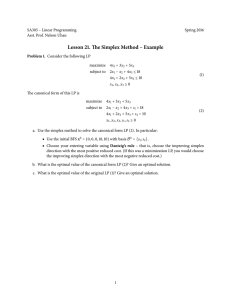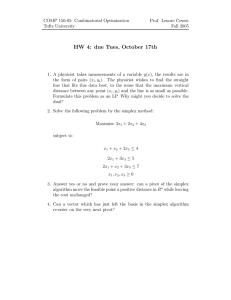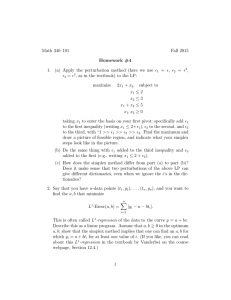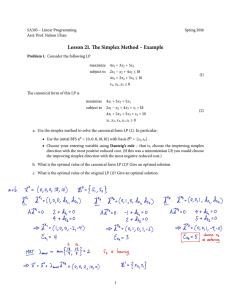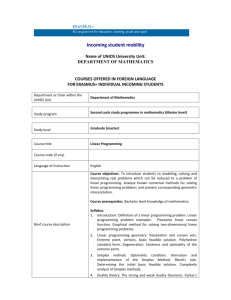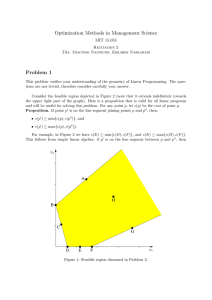Exam 2 Instructions
advertisement
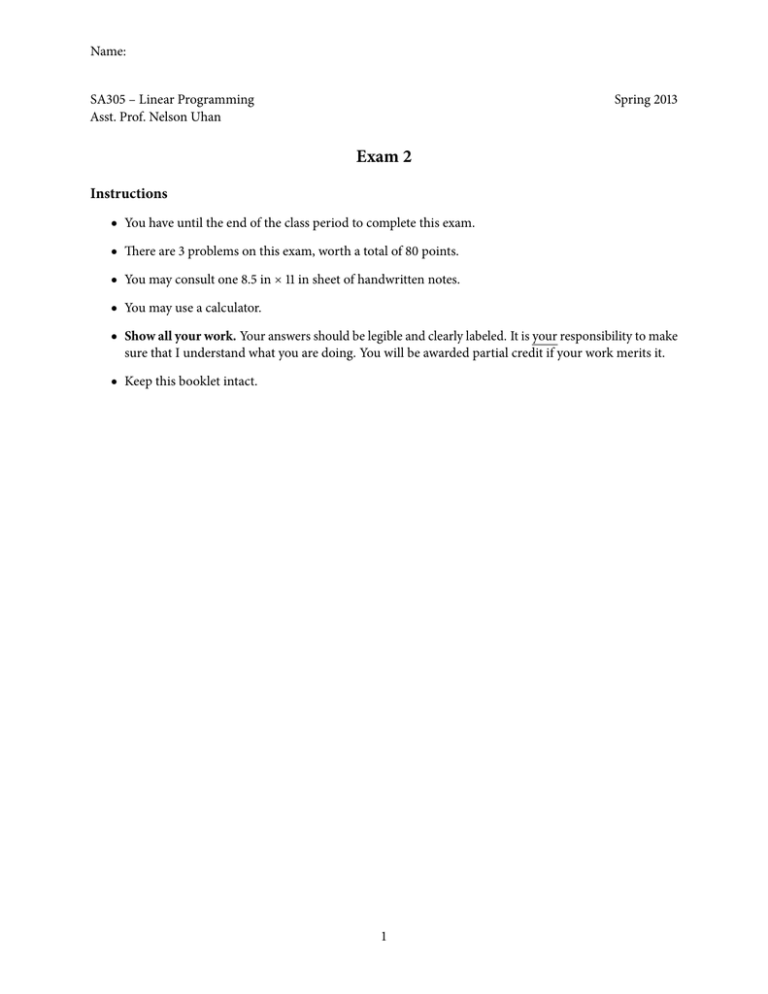
Name:
SA305 – Linear Programming
Asst. Prof. Nelson Uhan
Spring 2013
Exam 2
Instructions
● You have until the end of the class period to complete this exam.
● There are 3 problems on this exam, worth a total of 80 points.
● You may consult one 8.5 in × 11 in sheet of handwritten notes.
● You may use a calculator.
● Show all your work. Your answers should be legible and clearly labeled. It is your responsibility to make
sure that I understand what you are doing. You will be awarded partial credit if your work merits it.
● Keep this booklet intact.
1
Problem 1. (40 total points = 5 points × 8 parts)
Consider the following linear program.
maximize 2x1 + 3x2 − x3
subject to x1 + 2x2 + x3 = 5
(1)
−x1 + x2 + x3 ≥ 1
(2)
x1 + x2 + 2x3 ≤ 8
(3)
≥0
(4)
≥0
(5)
x1
x2
a. Which constraints are active at the solution (2, 0, 3)? Use the letters next to each constraint to indicate
your answer.
b. Is d = (−1, 1, −1) a feasible direction at (2, 0, 3)? Justify your answer.
c. Is d = (−1, 1, −1) an improving direction at (2, 0, 3)?
d. Could the solution (2, 0, 3) be an optimal solution to the linear program? Justify your answer.
2
e. Is the solution (2, 0, 3) a basic solution? Justify your answer.
f. Is the solution (2, 0, 3) an extreme point? Justify your answer.
g. Is the solution (2, 0, 3) degenerate? Justify your answer.
h. Convert the linear program to canonical form.
3
Problem 2. (30 total points)
Consider the following linear program:
maximize 2x1 + x2 + 3x3 − 20x4
subject to x1 − x2 + 3x3 + 5x4 = 2
−x1 + 2x2 + 3x3 + 4x4 = 3
x1 , x2 , x3 , x4 ≥ 0
a. (7 points) At the basic solution (7, 5, 0, 0) what are the basic and nonbasic variables?
b. (7 points) At the basic solution (7, 5, 0, 0), one of the simplex directions is (−9, −6, 1, 0). What is the other
simplex direction? Are any of the simplex directions improving?
4
c. (7 points) At the basic solution (0, 31 , 97 , 0), calculate the step size if the simplex direction d = (1, 23 , − 91 , 0)
is used. What are the entering and leaving variables?
d. (7 points) Write the Phase I linear program.
e. (2 points) Professor May B. Wright says, “At the basic solution (0, 0, 73 , −1), we could compute simplex
directions even though it’s an infeasible solution! Then, we just choose an improving direction and see if
we become feasible!” Assume that the simplex directions at this solution are (1, 0, 3, 2) and (0, 1, − 143 , 3).
What goes wrong if you try this?
5
Problem 3. (10 total points = 2 points × 5 parts)
True or False. Circle the correct answer. No justification needed.
a. True
False
To prove that the function f (x) = −∣x∣ is not convex, we can simply note that
2
1
1⎫
⎪
f ( (−1) + (1)) = − ⎪
⎪
⎪
3
3
3⎪
⎬
1
2
⎪
⎪
f (−1) + f (1) = −1 ⎪
⎪
⎪
3
3
⎭
b. True
False
2
1
2
1
f ( (−1) + (1)) > f (−1) + f (1)
3
3
3
3
⇒
To prove that the set {(x, y) ∶ y = f (x) ≥ −1} is convex, we can simply note that
2
1
1⎫
⎪
f ( (−1) + (1)) = − ⎪
⎪
⎪
3
3
3⎪
⎬
2
1
⎪
⎪
f (−1) + f (1) = −1 ⎪
⎪
⎪
3
3
⎭
2
1
2
1
f ( (−1) + (1)) > f (−1) + f (1)
3
3
3
3
⇒
For parts c-e, define the set
x − y ≥ −1
S = {(x, y) ∶
}
x−y≤1
The set S is drawn below.
y
2
1
-3
-2
-1
1
2
3
x
-1
-2
c. True
False
The set S is the feasible region of a linear program but has no extreme points.
d. True
False
Converting the constraints that define S into canonical form yields the constraints
x + − x − − y+ + y− − s1 = −1
x + − x − − y + + y − + s2 = 1
x + , x − , y+ , y− , s1 , s2 ≥ 0.
A linear program with these constraints has no extreme points.
e. True
False
The following optimization problem is unbounded:
maximize
−x+y
6
subject to
(x, y) ∈ S
